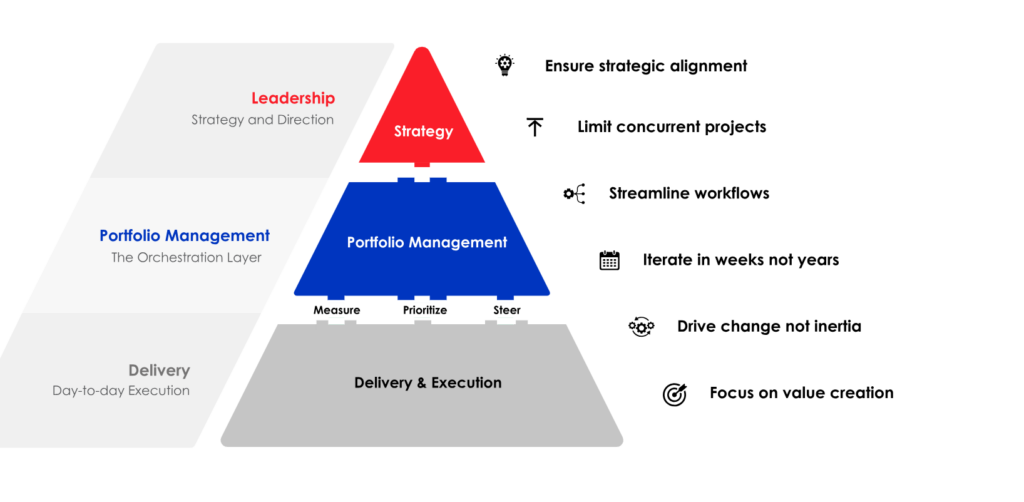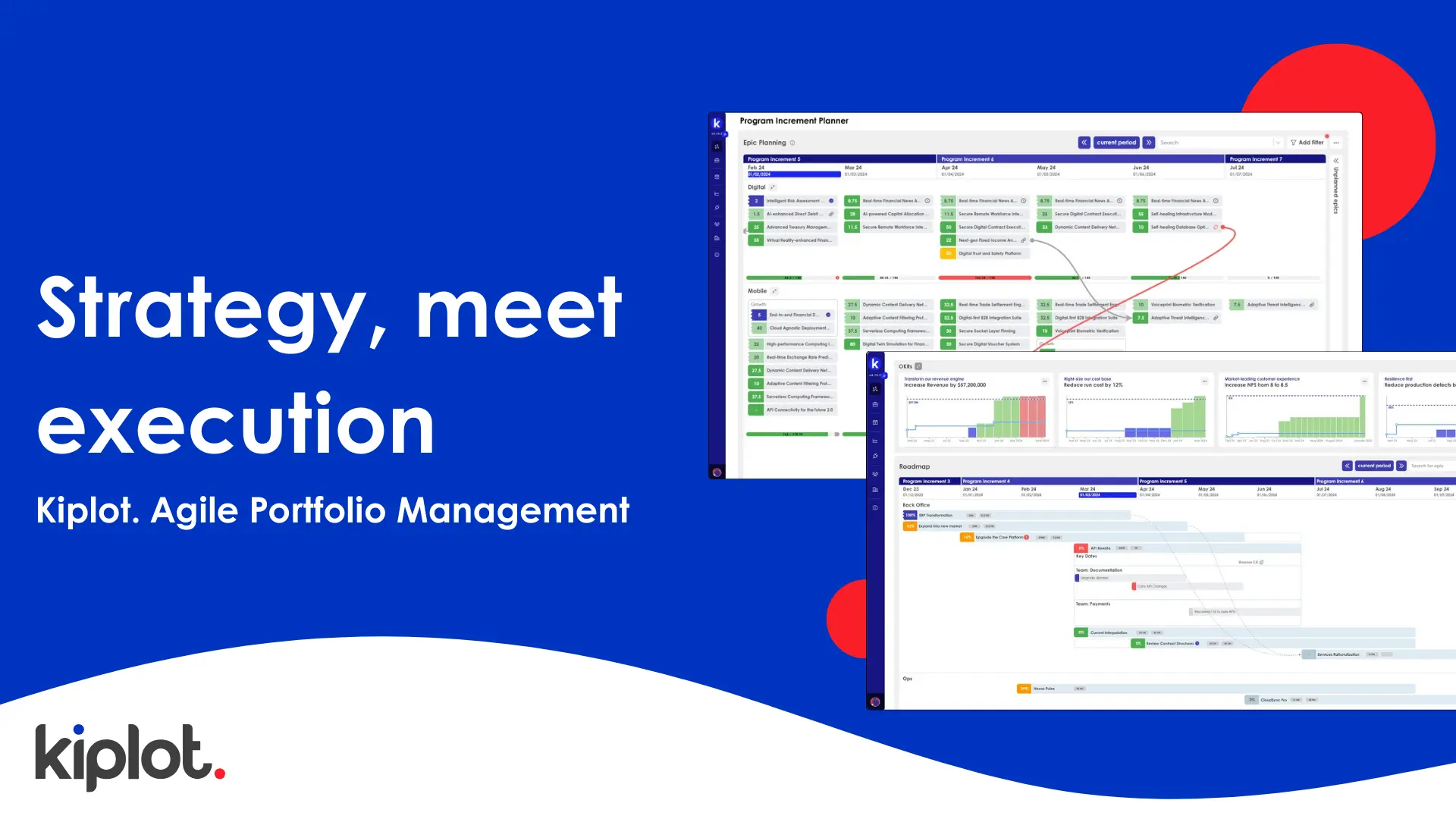Introduction
As organizations grow and scale, so does the complexity of managing their portfolios. For CIOs, PMO leaders, and transformation managers, the challenge is no longer about overseeing isolated projects but orchestrating a diverse array of initiatives that span departments, geographies, and delivery methods. This is where enterprise project portfolio management (EPPM) becomes a key function to enable strategic growth.
Unlike traditional project management, which focuses on delivering individual projects on time and within scope, EPPM takes a broader view. It’s about ensuring that every project, program, and initiative is aligned with the organization's strategic objectives, providing insights that drive better decision-making and ultimately driving value delivery at enterprise-scale.
This guide offers a strategic look at EPPM—exploring its core principles, the challenges it addresses, and how it enables leaders to transform their approach to managing project portfolios. Whether you’re looking to align your Agile transformations with business goals or seeking to gain visibility into portfolio performance, this article provides the insights you need to to gain a solid understanding of the principles of enterprise-level portfolio management.
What is Enterprise Project Portfolio Management?
Enterprise project portfolio management (EPPM) is the strategic backbone that enables enterprise organizations to align their initiatives with overarching business goals. At its core, EPPM ensures that each project, program, and initiative directly contributes to the enterprise’s strategic objectives, making it possible to prioritize the right work, allocate resources efficiently, and deliver measurable value.
While traditional project management focuses on managing individual projects and their immediate outcomes, EPPM takes a holistic view. It considers the entire landscape of projects, assessing how they interact, overlap, and impact one another. For CIOs, PMO leaders, and enterprise transformation managers, this means a shift from merely tracking project progress to ensuring that the entire portfolio is aligned with the organization's strategic roadmap – driving incremental value delivery in a managed and consistent manner.

EPPM is designed to answer critical questions that senior leaders face daily:
- How do we ensure that our project portfolio aligns with our long-term strategic vision?
- Which initiatives should we prioritize, and where should we allocate our resources?
- How can we quickly adapt to market demands without compromising our ongoing projects?
By focusing on the bigger picture, EPPM helps organizations navigate the complexities of managing multiple projects while ensuring that every effort drives strategic growth. It’s not just about delivering on time and on budget—it’s about delivering the right outcomes that move the business forward.
Key differences between EPPM and traditional project management
| Aspect | EPPM | Traditional Project Management |
| Scope | Manages multiple projects across the entire organization | Focuses on individual projects |
| Focus | Strategic alignment with business goals and long-term value | Delivering projects on time, within scope, and on budget |
| Decision-Making | Data-driven, prioritizing projects based on strategic importance | Often reactive, focusing on immediate project needs |
| Visibility | Provides a holistic view of the entire portfolio with real-time insights | Focuses on progress and status of individual projects |
| Resource Management | Optimizes resource allocation across multiple projects and programs | Manages resources at the project level |
| Flexibility | Supports various delivery methods (Agile, waterfall, hybrid) | Typically follows a single delivery approach per project |
| Risk Management | Proactively identifies risks across the portfolio | Manages risks within the scope of a single project |
| Outcome Measurement | Focuses on value realization and alignment with strategic outcomes | Focuses on meeting project-specific deliverables |
| Adaptability | Adjusts project priorities and resource allocation as business needs change | Less flexible, with changes impacting project scope and timelines |
Strategic importance of Enterprise Project Portfolio Management
Enterprise project portfolio management (EPPM) serves as the bridge between strategy and execution, rendering it essential for organizations looking to pursue innovation whilst remaining and responsive and adaptable to market demands.
Key strategic objectives of EPPM include:
Aligning initiatives with business goals
EPPM ensures that every project and program within a portfolio is directly tied to strategic priorities. This alignment helps organizations focus their efforts where they will have the most impact, ensuring that resources are allocated to the projects that drive growth, improve efficiency, or support innovation.
Improving visibility across the portfolio
Visibility is a common challenge in large enterprises where multiple projects run simultaneously across various departments. EPPM provides a clear view of the entire project landscape, offering immediate insights into progress, resource usage, and potential bottlenecks. This enhanced visibility enables leaders to identify risks early, adjust priorities as needed, and ensure that the portfolio stays on track to deliver value.
Balancing agility with control
Incorporating Agile methodologies into enterprise settings often presents a paradox: how can leaders allow teams to operate with agility while maintaining the oversight needed to meet strategic goals? EPPM is designed to balance these demands. It accommodates diverse delivery methods, whether Agile, hybrid, or waterfall, and provides a unified approach to managing them. This flexibility helps organizations adapt quickly to changes without sacrificing control over their strategic objectives.
By focusing on strategic alignment, visibility, and adaptability, EPPM transforms project management from a process-driven activity into a strategic advantage. It enables leaders to ensure that their portfolios don’t merely support the business but actively propel it forward.
Core principles of Enterprise Project Portfolio Management
These key themes of EPPM provide the foundation for strategic alignment, effective resource allocation, and a clear understanding of portfolio performance.
Portfolio prioritization
Prioritizing initiatives is fundamental to EPPM. It ensures that resources and attention are directed toward projects that align most closely with strategic objectives. Effective prioritization involves evaluating the potential impact of each project against business goals and making informed decisions about what should move forward. This approach helps enterprises remain focused on what will deliver the most value, ensuring that lower-priority projects don’t divert attention from critical initiatives.
Resource and capacity management
One of the toughest challenges for senior leaders is managing resources effectively across numerous projects. EPPM offers a structured approach to understanding resource capacity, helping organizations allocate personnel, budget, and time to the projects that matter most. By maintaining a clear picture of available capacity, leaders can avoid overcommitment, reduce resource bottlenecks, and ensure that critical projects are adequately supported.
Performance tracking and value realization
Tracking performance is key to understanding whether projects are meeting their intended outcomes. EPPM provides the tools needed to monitor progress against key metrics, evaluate the return on investment, and adjust plans when necessary. This ensures that projects are not only completed but also deliver the anticipated value, helping to justify ongoing investments and adapt strategies as market conditions change.
By focusing on these core components, EPPM enables enterprises to operate with greater clarity and control. It ensures that projects contribute meaningfully to strategic goals and provides the structure needed to navigate complex portfolios with confidence.
Technology in Enterprise Project Portfolio Management
Technology provides the backbone that allows organizations to gather real-time insights, integrate seamlessly with existing tools, and adapt quickly to evolving priorities.
Integration with existing tools
EPPM platforms need to work with the tools that teams already rely on, such as Jira, Microsoft Project, and other Agile or project management software. Seamless integration means that data flows smoothly between systems, reducing manual input and creating a single source of truth for project progress. This connectivity allows leaders to oversee portfolio performance without disrupting the existing workflows of delivery teams, ensuring that no information is lost in translation.
Real-time data and analytics
Access to real-time data is a key requirement for successful EPPM at organizational-level. It provides leaders with up-to-the-minute visibility into how initiatives are progressing, where resources are being used, and where potential risks might emerge. With analytics and dashboards tailored to their needs, decision-makers can pivot strategies quickly, reallocating resources to high-priority projects or adjusting timelines to address challenges. Real-time insights make EPPM a dynamic framework, allowing enterprises to respond to shifts in the market and internal priorities.
Scalability and flexibility
Enterprises operate on a different scale than smaller organizations, and their EPPM solutions must scale with them. A robust EPPM platform is designed to handle increasing complexity as new projects, programs, and teams are added. It’s also flexible, adapting to different methodologies—whether Agile, waterfall, or hybrid—without sacrificing consistency in oversight. Scalability ensures that as an organization grows, the EPPM framework grows with it, maintaining its effectiveness.
By leveraging the right technology, EPPM becomes more than a management tool—it transforms into a strategic asset. It enables organizations to gain the visibility and agility they need to manage complex portfolios, ensuring that technology drives real value across the enterprise.
Key challenges in Enterprise Project Portfolio Management
Even with the right framework in place, large-scale Enterprise Project Portfolio Management (EPPM) comes with challenges. For leaders orchestrating complex project portfolios, understanding these hurdles—and how to address them—can be the difference between success and stagnation.
Balancing agility with control
Organizations that adopt Agile practices often struggle with maintaining the balance between allowing teams the freedom to adapt and keeping overall strategic alignment. Leaders might find that teams prioritize speed and autonomy, which can lead to misalignment with long-term business goals. To overcome this, EPPM frameworks should be designed with flexibility in mind, allowing teams to adapt their processes while still maintaining visibility and accountability at the portfolio level. This helps ensure that Agile teams can operate efficiently without losing sight of strategic importance of the value they create.
Managing change at scale
Change is a constant in any enterprise organization, but when projects are spread across departments and regions, managing that change becomes a challenge. Whether it's shifting priorities, reorganizing teams, or adapting to market trends, change can disrupt even the best-laid plans. Effective EPPM relies on having a clear change management process that aligns with the strategic direction of the organization. This means setting up governance structures that allow for quick decision-making and a clear understanding of how changes impact the overall portfolio.
Ensuring cross-team alignment
One of the most significant challenges in EPPM is fostering alignment across various teams and departments. Silos can form, communication can break down, and teams may focus on their own objectives rather than the organization’s broader goals. To tackle this, EPPM should include mechanisms for regular cross-team communication, like portfolio review meetings or centralized dashboards that highlight how each team's work contributes to strategic goals. These practices help maintain alignment and keep everyone focused on the same outcomes.
Key areas of focus for enterprise project portfolio management leaders
For EPPM leaders, the focus isn’t just on keeping projects on track—it’s about driving the initiatives that deliver real business value and fostering continuous growth. Below, are some key areas of focus for organizations looking to optimize their project portfolio management.
Aligning work with strategic priorities
A core responsibility for EPPM leaders is ensuring that all projects are tightly aligned with the organization’s strategic goals. By prioritizing initiatives that support key objectives, EPPM helps enterprises focus resources and effort where they will make the most significant impact. This alignment guarantees that critical projects not only get completed but also contribute directly to business growth and competitive advantage.
Measuring value, not just outputs
EPPM shifts the focus from traditional project metrics, like timelines and budgets, to a value-based approach. Instead of merely tracking whether a project was completed on time, EPPM leaders emphasize measuring the actual value each initiative brings to the organization. This approach enables more informed decision-making about which projects to continue, scale, or adjust—ensuring the entire portfolio is consistently delivering outcomes aligned with strategic priorities.
Building a culture of continuous improvement
At the heart of EPPM is a commitment to continuous improvement. By regularly reviewing portfolio performance and drawing lessons from completed projects, EPPM leaders foster a culture of learning and adaptation. This continuous feedback loop allows the organization to refine processes, stay agile in the face of change, and ensure ongoing alignment with both current and future business needs.
Conclusion
Enterprise Project Portfolio Management (EPPM) is a powerful tool for leaders who want to ensure that their projects and initiatives truly drive strategic value.
Kiplot is built to support this transformation, no matter what frameworks your organization relies on. Whether you’re using Agile, waterfall, or a hybrid approach, Kiplot’s platform provides the flexibility to integrate with existing delivery tools like Jira and offers real-time insights into portfolio performance. This adaptability means that even as your organization evolves, Kiplot ensures your projects stay aligned with strategic objectives and deliver measurable value.
For CIOs, PMO leaders, and transformation managers, the ability to oversee and adapt a portfolio in real-time is invaluable. With EPPM—and the capabilities of Kiplot—you’re equipped not only to track project progress but to steer it toward outcomes that matter most to your business. Whether you’re facing challenges in balancing agility with control, managing change, or ensuring that every project supports your long-term vision, Kiplot provides the structure and insight needed to stay on course.
The strategic advantages of EPPM are clear: improved decision-making, better alignment with business goals, and the ability to continuously refine and optimize how work gets done. For organizations aiming to lead in their industries, adopting an EPPM approach—and leveraging tools like Kiplot—isn’t just a best practice—it’s a strategic necessity.

